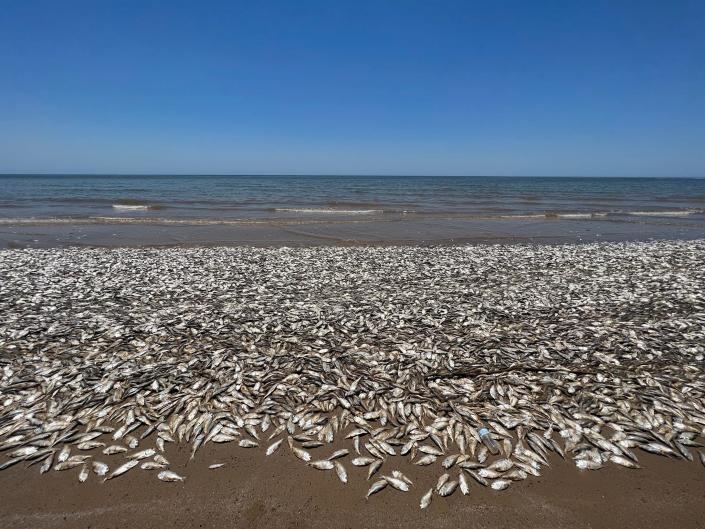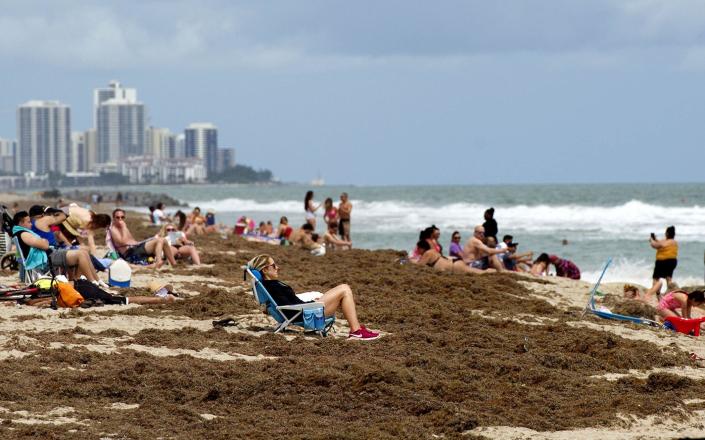Elizabeth Weise, Asbury Park Press
Sat, June 17, 2023
As Americans flock to the beach this summer, they're often greeted with disconcerting news: Their destination might be smelly with dead fish or rotting seaweed — and danger often lurks from rip currents or even shark attacks.
In a warming world, those problems are set to get worse, experts say.
"The climate is changing and it's changing drastically," said Todd Crowl, director of the Institute of Environment at Florida International University in Miami. "It is measurable and happening."
No single ruined beach day should be directly attributed to a warming globe. But the rise in both atmospheric and ocean temperatures is rapidly altering the stretches of coastline where land and water meet.
The most obvious impact is rising sea levels that over years will erode beaches, threaten coastal homes and swamp stretches of coastline. But some climate change effects are less obvious and beginning to unfold right now.
This year could be a portent of even more extreme, seashore-ruining, events. The National Oceanic and Atmospheric Administration announced Wednesday that global ocean temperatures hit a record high in May, the second consecutive month where ocean temperatures broke a record, the National Oceanic and Atmospheric Administration said.
Here are just a few ways warming oceans may affect beaches in the U.S.

Thousands of dead fish washed up on beaches along the Texas Gulf Coast, including Quintana Beach County Park.
Smelly dead fish
What's happening? Thousands of dead fish recently washed ashore in Texas, creating a smelly, disgusting mess some on beaches.
The same thing happened in Louisiana last June when soaring temperatures and storms caused a "rash of fish kills," according to the state Department of Wildlife and Fisheries. Florida had a major event in 2020 that killed tens of thousands of fish in Biscayne Bay.
"The oxygen went to zero, everything died," said Crowl. "It was very sad, we had one section where there were 20 or 30 sting rays swimming upside down trying to gasp for air."
Such die-offs can lead to rejuvenated water systems once temperatures return to normal, adding nutrients to the water and bottom. But when they're happening they make beaches smelly and unappealing. In Texas, officials warned people to stay out of the water due to high levels of bacteria and sharp fins on the rotting fish.
Why is it happening? Warmer water holds less oxygen. When water temperatures rise above 70 degrees, it became hard for the Texas fish, mostly menhaden, to receive enough oxygen to survive, Quintana Beach County Park officials said.
Is climate change to blame? Heat-caused fish kills have long occurred in shallow coastal areas but the concern is as overall ocean temperatures rise, they will become more common.
"We hadn't seen a fish kill in 20 years and now we've seen three in three years," Crowl said of Florida.
Increasing water temperatures due to climate change may make low oxygen conditions worse in locations around the U.S. that are susceptible to hypoxia, and in extreme cases fish kills, caused by extremely low oxygen, say experts with NOAA's National Ocean Service
There's also a negative feedback loop involved because fish are endothermic, meaning they are the same temperature as the water they're swimming in. As the water warms up, their metabolism increases, which increases their need for oxygen, said Andre Boustany, global science director at the Monterey Bay Aquarium in Monterey, California.

Giant blobs of Sargassum hug the shoreline next to the William O Lockhart Municipal Pier in Lake Worth Beach, Florida on June 1, 2023.
More stinky seaweed
What's happening? Beachgoers in Florida are dealing with heavy blankets of rotting brown seaweed as an enormous swath of sargassum drifts westward and piles onto white sandy beaches.
"You're basically swimming through rafts of sargassum," said Kevin Boswell, director of the marine biology program at Florida International University. "It's itchy and scratchy, it's like swimming through bushes."
Sargassum, a naturally occurring type of macroalgae, has grown at an alarming rate this winter. The belt of ocean where it naturally occurs stretches across the Atlantic Ocean from Africa to Florida and the Yucatan Peninsula and is as much as 200 to 300 miles wide.
The seaweed mats grow larger when they have more nutrients, which they’re getting as dust is blown out to sea from the Sahara Desert in Africa. These bring fertilizing iron and phosphorus to the water, allowing the mats to grow.

Large mats of Sargassum seaweed does not keep sunbathers away from Midtown Beach Palm Beach on March 30, 2019. [Meghan McCarthy/palmbeachdailynews.com]
Is climate change to blame? More frequent appearance of these seaweed blobs along the US coast are likely due to multiple factors, say, scientists, including climate change. But warmer ocean temperatures stimulate growth of the seaweed blobs.
"It's always come in some amount to the coast of Florida," said Arlo Hemphill, project lead for ocean sanctuaries with Greenpeace. "But this is completely new. You might get a foot of sargassum, which was quickly cleaned up. What we're talking about now is not a foot, it's many feet high. It's completely unmanageable."
Dangerous rip currents
What's happening? Each year more than 100 Americans die in rip currents, according to the US Lifesaving Association.
Could climate change make it worse? As the atmosphere warms, it's adding additional energy to the global environment, because heat = energy.
"With climate change and global temp increasing, you’re putting more energy into the environment. One of the ways that energy can come out is in increased wave formation. Waves are just another form of energy, they’re kinetic energy," said Boustany.
Increased land temperatures also increase wind, which in turn increases waves. Both of those contribute to rip currents, which are the result of wave energy.
NOAA is studying this but so far the results are uncertain. Rip currents are known to be primarily caused by breaking waves at the beach, and tend to be more frequent and stronger with larger waves.
There's been some research suggesting climate change may increase wave heights in some locations. If wave heights do increase, rip current occurrence and intensity could increase as well, NOAA experts told USA TODAY.

TOPSHOT - An Atlantic White Shark Conservancy boat and crew work to tag a Great White Shark in the waters off the shore in Cape Cod, Massachusetts on July 13, 2019. - Three Cape Cod beaches were temporarily closed to swimming July 13, 2019 after great white sharks were spotted as close as 150 feet offshore, according to the Atlantic White Shark Conservancy. (Photo by Joseph Prezioso / AFP)JOSEPH PREZIOSO/AFP/Getty Images ORIG FILE ID: AFP_1IR00AMore
Sharks on the move
What's happening? Sharks are showing up more in areas inhabited by humans. It's partly because shark populations are increasing due to decades of conservation, but also because the prey they eat, including fish, seals, sea lions and squid, are moving as ocean temperatures warm.
In some cases, these shifts are changing sharks' migratory patterns, bringing them into greater contact with humans in the water. Studying this is one of NOAA's priorities.
Shark attacks remain rare and appear to be holding steady, but the sight of a 10-foot Great White is still enough to clear beaches and keep even the most avid swimmers out of the water.
Where's it happening? Wherever there's unusually warm ocean water, but scientists are seeing it especially on the West Coast, said Boustany.
Is climate change to blame? Climate change is warming the oceans which is driving this behavior as sharks, an apex predator, follow their prey.
More red tides
What's happening? Red tides are the common name for what scientists call harmful algal blooms. They occur when colonies of plant-like organisms called algae grow out of control. Some can produce toxic or harmful effects on people, fish, marine mammals and birds. The name "red tide" comes because some forms stain the water red.
"They're happening more and more frequently and they're happening in places where they really haven't before," said Crowl.
Is climate change to blame? While Texas and the Gulf Coast of Florida have always experienced such tides, they're now beginning to occur in the Florida Keys and the beaches near Miami, said Crowl.
"We just launched a big project with NOAA to build early warning sensors for red tides so we can warn people before they become harmful," he said. "They can cause respiratory problems in children so we have to send out warnings to not swim on this or that beach when they're present."
Beaches are disappearing
What's happening? Sea level rise and increasingly ferocious storms are predicted to eventually engulf many of the world's beaches, but that's not expected to happen for decades. However, some areas are already beginning to see the effects of higher sea levels.
“Sea level rise is something we’ve been measuring for 100 years,” said Crowl. “It’s not a prediction, it’s not a guess. It’s reality.”
Because of that, there are days in Florida when there's a full moon, a high tide and westerly winds when some beaches literally disappear because the water goes all the way up to the dunes, Crowl said from St. Augustine, along Florida's northern Atlantic coast.
Is climate change to blame? A study released in 2020 predicted half the world's beaches could disappear in the next 75 years due to climate change. A 2023 study found 70% of California's beaches could be threatened.
"We already see times when you can't get to the beach unless you're willing to wade – and our beach is 75 feet wide a low tide," Crowl said.
This article originally appeared on Asbury Park Press: Gross climate change effects soil US beaches: Seaweed, dead fish
No comments:
Post a Comment